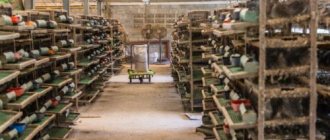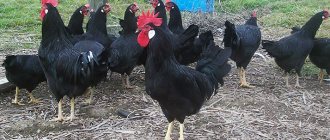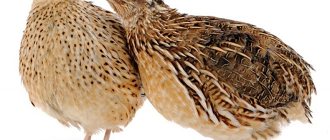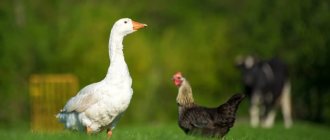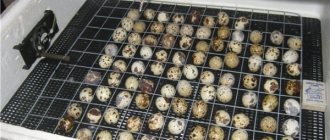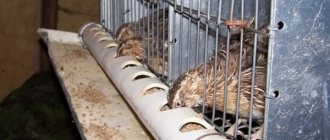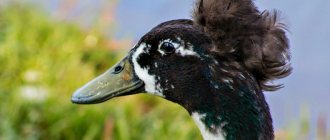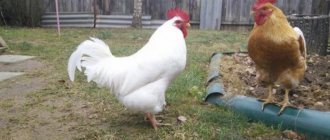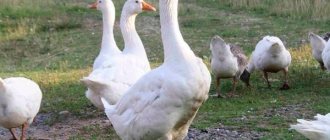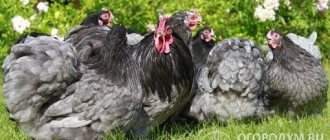Home » Articles about quails » Quails in the country
Breeding quails in the country can bring good profits - the birds are unpretentious and do not require a lot of space to keep them. Due to their high precocity, about 150 eggs can be obtained from each female during the summer season.
Keeping quails in the country
This process is not particularly demanding.
- This is due to the fact that 20-30 quails feel great in one cage measuring 100x40 cm.
- They do not need to walk, but they should take care of lighting (17 hours a day) and the required humidity (50-70%). Light can be organized from simple lighting fixtures, the batteries can be positioned so that the temperature in the cells does not exceed 25-28 degrees. If the bird lives outdoors, it must be protected from rain and wind; the cages should be placed under a dense, waterproof and windproof canopy.
- In the summer, at your dacha, you have almost all the conditions ready for breeding quails - you can build cages yourself from scrap materials, the main thing you need to know is that water and food should be located outside the living space - this way you will significantly save on food and prevent rapid contamination of the feeders. Therefore, the openings in the cages should be such that the bird’s head can easily fit between the bars to drink or peck food.
- Another factor in the question of how to breed quails is the delicate nervous system - quails, they are afraid of sharp noises, larger animals (that is, almost all), loud music and screams, as well as strangers' hands (only the owner should care). If these conditions are not met, then the laying hens may experience stress, and as a result, a sharp decrease in egg production. Therefore, the cages should be placed in the far corner of the garden or garden.
It should be noted that it is worth starting with a small number of individuals, without purchasing an incubator - ten pieces will be enough.
Breeding quails in the country
It is better to buy mature chicks, the females of which will be able to lay eggs in a couple of weeks.
Incubators for chicks
When everything is ready for breeding quails, it is time to take care of purchasing chicks. Experienced poultry farmers who have been breeding quails for many years have acquired incubators. You can buy this device ready-made in a store or make it yourself, for example, from an old refrigerator. It is not profitable to constantly buy new chicks. In addition, long-term transportation, plus adaptation to new living conditions, negatively affects young animals. Sometimes this process is accompanied by a large mortality rate of birds. Quails are very unpretentious in incubation. Even an inexperienced person can hatch chicks. The main thing is to maintain the temperature and humidity inside the incubator. The only problem can be purchasing high-quality quail eggs for the first time. If this is not possible, you will have to buy chicks for the first hatch. When the quails grow up and begin to lay eggs, you can begin to hatch your young in the incubator.
How to breed laying quails in the country
Raising quails in the country for beginners will not be difficult if you approach the work comprehensively
To do this, you should pay attention to the correct conditions of detention and a balanced diet.
Despite the fact that quail eat little food, it should be saturated with essential vitamins and minerals. Be sure to purchase medications in advance to prevent and eliminate the most common diseases that quail suffer from. The complete technology of breeding and growing must be maintained.
Peculiarities
Those who breed quails should know the physiological characteristics of the bird and pay attention to several important factors when breeding them:
- The greatest productivity of poultry is maintained at a room temperature of +18 - +20°C. At elevated temperatures, females' productivity decreases; low temperatures can cause the death of young animals.
- Take care of special cages for quails. You can buy them or make them yourself from plywood or metal mesh. Keep in mind that egg breeds require more space.
- Take care of the proper nutrition of the bird: add finely chopped greens, crushed grains, and mineral supplements to the diet.
Rules
Successful raising of quails in a country house or in an apartment depends on a few simple rules:
- On average, for 4 birds (3 females and 1 male), you need to provide a cage 0.3 by 0.3 m. The height of the cage is at least 25 cm. Be sure to lay a thin layer of straw, hay or shavings on the floor, which is replaced when it gets dirty.
- To increase the egg production of a bird, you can increase daylight hours for the bird using artificial lighting. But you need to remember that you shouldn’t do this all the time, as the bird may become more aggressive.
- In the quail room, even in winter, the temperature should not fall below +16°C. It should be frequently ventilated and free of drafts.
- To reduce the risk of diseases and parasites in poultry, place shallow dishes with ash in the cages once every 7 days.
- Drinking water should be changed at least 2 times a day; it should be constantly clean and at room temperature. Do not use deep drinking bowls.
Breeding quails on a private farm requires the same conditions.
Incubation
If hatching material is purchased or fertilized eggs from your own stock appear, you will need an incubator. It is convenient to use a model with automatic reversal. The total duration of incubation is 16-17 days. For the first week, maintain temperature/humidity at 37.8°C/50-55%. Turn eggs - 6 times a day. The next week, the humidity is reduced to 45%, the temperature remains the same.
Turn the eggs in the same mode, but add 2 cooling sessions per day for 15-20 minutes. From the 15th day until hatching, turning and ventilation are stopped, the temperature is set at +37.5°C. Humidity is increased to 70%. Dried chicks are moved to a brooder for 2-3 weeks. The first days the temperature should be +37°C. By day 8 it is reduced to +28…+30°C, by day 22 – to +25°C. The grown chicks are moved into cages.
Step-by-step instructions for making cells from various materials
Now let's look in more detail at how to make a quail cage with your own hands from all of the above materials.
Metal mesh structure
The provided option involves the manufacture of a cage to house 20 adult individuals. It will be optimal for beginner poultry farmers.
It is assembled on the basis of a frame made of a metal corner (25 mm). Depending on the capabilities of the room in which the cage will be installed, the dimensions can be slightly changed for convenience. For the floor we take a mesh with cells of at least 16x24 mm; for the walls and ceiling it can be larger so that the bird’s head can fit through.
The process of manufacturing the structure itself contains the following stages:
We prepare the corner according to the dimensions we need and weld it into a frame, as shown in the diagram:
- We cut the metal mesh to the size of our walls and attach it to the slats with wire so that the twisted tendrils are on the outside.
- When cutting out the floor, an egg tray of up to 100mm in length should be taken into account. We bend its end upward by 30-40 mm to fix the eggs, and cover it with sides on both sides. We leave a gap of up to 30 mm between the front wall and the egg collection tray. The eggs will pass through it.
- We make a rectangular hole in the center of the front wall so that through it you can reach any point in the cage.
- We cut out a door from the mesh and fix it on top using either galvanized strips (20x40) or canopies.
- We cut out a rectangle from a galvanized sheet and bend the sides on all sides. You should get an ordinary pallet, identical in width and length to our cage. It is placed under the structure and will serve as a collection for droppings.
There is also a frameless cage for quails, the production of which is less labor-intensive, although its design is not as reliable as in the first option. Here is a cutting diagram and construction order:
- We bend the metal mesh into the shape of a box without the side parts, and later attach them using wire.
- The tray for collecting eggs is provided as a continuation of the floor, with a slope towards the front and is similar to the frame method. Its size is up to 100 mm. Also, don’t forget to make a safety rim to keep the eggs from falling.
- We additionally cut out the bottom from a finer mesh.
- As in the first option, we install a door and a litter tray.
You can clearly see all the stages of making a quail cage discussed above in the following video. Also in it, an experienced farmer gives useful recommendations to beginners:
Plywood cage
Such a cage can be made either on the basis of a metal frame or by connecting it together using wooden blocks:
- From plywood we cut out the side walls 35x20 cm, the end wall 70x20 cm and the lid 70x35 cm. For lighting and ventilation we make holes in the planes (diameter - about 3 cm).
- We coat all parts with water-based varnish.
- Assembly is carried out using self-tapping screws, which fasten the walls to the bars located at the inner corners of the structure. For reliability, the joints can be treated with glue.
- We cut out the floor from a metal mesh with a cell of at least 16x24 mm. You can attach it with small nails or a furniture stapler, taking into account the angle of inclination.
- In place of the front wall, we cut out a door from a mesh, which we attach to canopies or galvanized strips.
Plastic
Due to its simplicity and low cost, an excellent option would be to make a quail cage from mesh plastic boxes, which are used for transporting and storing vegetables. To build one cage, you need 2 low drawers and 1 at least 170 mm in height:
- Using a hacksaw, we saw off the corners that protrude from the top of the drawers.
- We put the big one on one of the small ones, it will serve as a pallet. We cover the top with the second small one, this will become our ceiling. It is clear that the width and length of all boxes must be the same. We fasten the structure with wire. To avoid injury to birds in the future, the “antennae” of the twists should be on the outside.
- We saw through three of the four sides of the top drawer. This will be a door whose hinges will be the fourth (uncut) side.
- Using a knife, we enlarge the holes in the planes of the cage. The quail will feed through the cells in the front part; the bird's head should fit into them.
I would like to tell novice poultry farmers that the hassle associated with breeding quails is worth the fact that you will have your own (at first small) poultry farm, full of nimble birds, from caring for which, in addition to commercial benefits, you will receive a lot of joyful moments.
How to choose a productive breed?
Depending on the purpose of cultivation, quail breeds are divided into egg-laying and meat-producing ones. The characteristics of popular breeds can be found in the table:
| Name | Group | Egg production, pieces/year | Egg mass, g | Live weight, g | Fertility, % | |
| male | females | |||||
| Japanese | egg | 250-300 | 9-11 | 110-130 | 130-150 | 80-90 |
| Pharaoh | meat | up to 220 | 12-16 | 200 | up to 300 | 80-90 |
| White English | egg | about 280 | 10-11 | 160 | 190 | 75 |
| Black English | egg | 280 | 10-11 | 170 | 200 | 75 |
| Tuxedo | egg and meat | 280 | 10-11 | 140-160 | 160-180 | 80-90 |
| Marble | egg | 260-280 | 9-10 | 110-120 | 130-150 | 70 |
| Manchurian | meat | 220 | 16 | 150-200 | 300 | 80 |
| Estonian | egg | 300-310 | 12 | 170 | 200 | 95 |
| Population of NPO "Complex" | egg and meat | 260 | 11-12 | 150-170 | 180-200 | 70-80 |
The most popular breeds are:
- Japanese. Females begin laying eggs at the age of 1.5-2 months. They can lay up to 300 eggs per year. They are undemanding to living conditions and resistant to diseases. Domestic quails have a color similar to birds living in the wild.
- British (English) white and black. Less egg-laying than Japanese (280 eggs per year), but slightly larger. Obtained from mutations of Japanese quails. They have black plumage with a brown tint. Black quails have a higher mass compared to the white species.
- Manchurian golden ones. Egg production up to 250 eggs per year. They have a very beautiful color of feathers - brown and half-wheat, which gives the bird a pleasant golden hue.
- Pharaoh. It is in steady demand among farmers. Its coloring is reminiscent of Japanese quails. They begin to lay eggs at the age of 40-50 days, but produce relatively few eggs - about 200 eggs per year. Such quails are actively used for breeding broilers.
Weights
Even with proper feeding and careful care, the maximum weight of an adult will not exceed 350 grams. But due to the fact that quail meat is a dietary and very high-quality product, many poultry farmers choose meat when breeding quails. The characteristics of birds are such that it is not possible to simultaneously receive a large number of eggs and achieve good weight gain, so sparrowhawks have to choose one direction.
Egg production
This indicator for quails is exceptionally high. They can produce up to 300 eggs per year. Quail eggs are a very valuable product due to their high content of vitamins, microelements and non-fatty acids. Therefore, breeding quails for eggs is the highest priority among domestic poultry farmers. Females begin to lay eggs very early. The periods of quail egg production are described here. So, with good care, laying hens begin to lay eggs within a month. The period of activity lasts 8-9 months, but, in general, can last up to three years.
What to look for when purchasing?
It is better to buy animals from poultry farms and other places where breeding is carried out professionally. This allows you to avoid deception and receive comprehensive advice on maintenance and care.
Be sure to ask what kind of food the birds on the farms ate and follow this diet at least for the first time. A sudden change in living conditions will become stressful for the bird, and it may stop laying eggs.
Beginner breeders are advised to buy several adult individuals, which are much easier to care for.
Remember that a laying hen does not need a male to produce eggs - it is an autonomous process. But if you plan to get new offspring in the future, you will need at least one representative of the stronger sex.
The best age to purchase is 1.5 months, it is at this age that the female begins to lay eggs.
The season when you buy a bird does not matter, since birds still require artificial maintenance of the desired climate.
One-month-old quail - the optimal purchase age for inexperienced breeders
Important! When purchasing, carefully inspect the bird. Ruffled feathers, excess dirt on the beak and paws, moisture, a lethargic and sickly appearance should alert you
The same goes for the hoarseness and whistling that a quail can make.
Sanitary requirements
Disinfection of the premises and cleaning of cells
To exclude infectious diseases of quails, the premises, cages and equipment are disinfected. Frequency: at least 2 times a year, in a brooder - before the birth of chicks, in cages - before planting young animals and after illnesses.
To whitewash walls, use a solution of freshly slaked lime or milk of lime. Contaminated equipment, feeders and drinkers are washed with a 2% soda ash solution.
How to care for cells:
- litter trays are cleaned every day;
- Tray brooder feeders and drinking bowls are cleaned of food debris and dirt daily;
- Trough, bunker feeders, trough and cup drinkers are cleaned once every 4 days;
- nipple drinking systems must be cleaned after each broiler round: 3% hydrogen peroxide solution, 3-5% chlorine solution or 0.8% citric acid solution.
Handling the incubator and eggs
To prevent diseases of chicks, the incubator and eggs are disinfected:
- treating the incubator with a 1.5% ammonia chloride solution or a 2.0% dezmol solution;
- eggs are treated with a quartz lamp for up to 4 minutes;
- After laying, the incubator and eggs are treated with vapors of a 40% formaldehyde solution or a solution of potassium permanganate.
Important! Formaldehyde vapors are very harmful to humans and therefore they must be used in compliance with safety rules: wearing a mask and gloves. https://www.youtube.com/embed/aCcoYlH_gp8
conclusions
- Even an inexperienced poultry farmer can independently build a sparrowhawk (chicken coop), especially if he has a drawing, table and construction equipment.
- When constructing the structure, environmentally friendly materials should be used (you can use old wooden boxes or pallets).
- For summer walking (breeding), you need to build a portable aviary or pen for laying hens, large turkeys and a first-run nursery for two-week-old quails and younger.
Read about feed for quails in this material.
Choosing a location for the poultry house and period of maintenance
For the first experience, it is enough to have no more than a hundred quails. A poultry house can be a small extension to a country house or an insulated closed barn of up to 10 square meters. m.
The poultry house should be located on flat and elevated terrain.
In the wild, quails hide among thick grass, so it is better to build a poultry house in the shade of trees or buildings.
Quails love silence, so it is recommended to choose a quiet place away from the farm yard.
The period of keeping the bird depends on how much time you plan to spend at the dacha.
For short-term keeping of quails at the dacha in the summer, they are kept for 3-4 months. When broiler fattening, birds are kept for no more than 2 months.
With year-round breeding, quail continue to lay eggs throughout the year, after which they are slaughtered for meat.
Do you want meat? eggs? We learn how to properly keep and breed quails.
Contents:
A strange creature is a man. He actively destroys wildlife around him and no less actively raises animals and birds for himself. The recent peak is keeping quails. In general, a quail is a bird of the pheasant family from the order Galliformes.
They are very small in size, have a round head, featherless legs and a short beak. There are only 8 species of this bird. Quails are valued primarily because of their eggs, which contain a large amount of protein and are not allergenic. Quail meat is also used as dietary food. Only the lazy don’t grow them now. After all, they need no more care than chickens; if they are well kept, the birds do not get sick, and you can earn a lot of money from them.
Conditions of detention
The small size and unpretentiousness of birds make it possible to keep them almost anywhere - even in a city apartment. However, two important conditions must be met. The first is the presence of cages: the quail is still a wild bird. The second is an acceptable temperature. In cold conditions (below 5 °C), birds get sick and die, while hot conditions (above 25 °C) negatively affect the quality of feathers, as well as egg production.
Quail cage
If you keep birds in your country house, the place should be heated or equipped with heaters. Also in the room you need to ensure good ventilation and a humidity level above 65%. If it is not achieved naturally, you should place containers of water near the cells or use a spray bottle. During the summer day, cages can be placed in the yard. But it is necessary to ensure that there are no drafts and avoid contact with wild birds: quail run the risk of contracting various diseases.
Features of a homemade quail cage
Quail cages
To save money, you can make a bird house yourself, although professional buildings are better equipped. The size of the cells should be selected, remembering that per 1 sq. m. there should not be more than 6 individuals. Crowding reduces the productivity of birds, however, they also do not like spacious enclosures. Ceilings that are too high are also not suitable: attempts to fly up can lead to bruises.
Quail cage diagram
It is contraindicated to frighten birds with loud sounds or sharp flashes of light - they become alarmed and stop flying.
Feeding adult quails
Four quails eat the same amount of food as one chicken, but feeding them is much easier. Meals should be taken three times a day according to a schedule (food is better absorbed when it comes at the same time). The bird, as a rule, quickly manages its portion (about 30 grams per individual).
Feeding quails depending on age
Feed recipe for quails
It is better to install the feeder and drinker outside the cage, but so that the bird can reach it - for example, by sticking its head through the bars. Thanks to this, the cleanliness of the cells is better maintained. Otherwise, the bird may climb into the feeder, knock it over and mix the feed with droppings, which will waste money.
Feeding errors and their consequences
Quails do not require any exotic dishes - the birds' diet consists of crops familiar to us. For feeding you can use:
- Special feed from factories.
- Ground grain crops.
- Legumes, sunflower seeds, boiled vegetables, green onions.
- Herbs: dandelion, yarrow, cucumber leaves.
- Small insects.
Making a trough feeder
From time to time, you need to add substances containing calcium to the food: chalk, egg shells. The addition of minced fish has a beneficial effect on the health of birds. You should not give your pets parsley and tops, berries, sorrel, and buckwheat.
Additional tips for new farmers
For those new to quail breeding, we offer additional interesting tips:
- Avoid frequent body contact with birds. They do not trust a person and will try to get out of hand in every possible way, and can also become overly restless.
- In spring, it is good to feed laying hens with young nettles or dandelions.
- It is better to approach the cages smoothly and confidently, without unnecessary loud sounds or quick movements.
- Keep an eye on the birds when introducing new birds. Fights or excessive attention from the male to the female often occur.
- It is believed that quail droppings are good fertilizer.
Care and rearing of young quails
The quails hatched in the incubator are transplanted into a special heated cage, or boxes made of plywood or cardboard. Quail chicks need warmth - this is the main requirement for their successful keeping, which means they will need an electric heater, an infrared lamp or, with a small number of chicks, a simple 40-60 W incandescent lamp.
It is not difficult to set up a cage with your own hands for keeping young animals at home. This cage is suitable for 60 quails, ranging in age from one day to three weeks.
The width of the cage is 150 cm, the depth is 60 cm, the height is up to 40 cm. The front wall is made of removable mesh with a mesh size of 5x5 mm, the mesh floor is made of mesh with a mesh size of 1x1 cm, and a tray is installed under it to collect litter. All other walls are made of available materials - boards, plywood, chipboard; in such a box it is easier to maintain a stable temperature and shy quails will feel protected.
A lamp is placed in one part of the cage - there the young animals can bask, and on the other wall there are feeders and an automatic waterer on a jar. It is undesirable for the lamp to heat the water - the quail will not drink hot liquid. In the first week, the floor is covered with newspapers.
Young animals at the age of 24 hours need a temperature of + 37 °C, then the heating is gradually reduced. The temperature for keeping adult quails should be at least +19-20 °C. Air humidity – 60-70%.
The table below provides indicators for temperature and duration of illumination.
Temperature and lighting indicators
The cage with the quails should not be taken outside, even in good weather. Quail is a strong and resilient bird, but in adulthood. In young animals, even a light wind or a slight drop in temperature can lead to colds and death.
In the first two weeks, 24-hour lighting is installed for quails, then the photoperiod is gradually reduced. By the age of a month, quails are left with light for 12 hours a day. Then, for productive flocks kept per egg, daylight hours are increased starting from the fifth week, increasing to 16 hours by the eighth week.
In the first days, the diet consists of a feed mixture, which includes sifted cereals, usually millet, or mixed feed with chopped eggs, all finely ground. Some breeders give babies special feed from the first day, and in this case eggs are not fed.
Quail up to a week old are fed at least six times a day, gradually reducing the number of feedings, bringing the regime to two meals a day. After a month, the young animals can be given food for adults. It is impossible to abruptly transfer from one diet to another; the transition is made gradually. Read more about feeding quails in a separate article.
Newbie mistakes
Quails are considered the healthiest birds and are resistant to viral diseases. But with improper care, there is a possibility of death of the entire livestock. Several errors. Which beginners do:
- Changes in feeding schedule, irregular food supply. For better digestion, birds should be accustomed to eating at certain hours.
- Cereals and large amounts of carbohydrates are given in the evening. Thus, the bird does not feel hungry.
- Feeding liquid food. Too viscous consistency clogs the nasal passages and eyes of pets, causing suffocation and improper functioning of the digestive tract.
- Poor living conditions. Quail is a shy bird, so constant noise and sharp sounds negatively affect egg production and weight gain.
- Quail does not tolerate bright light and drafts. These conditions also lead to stressful conditions in birds.
- Insufficient disinfection leads to the rapid spread of infectious and viral diseases.
Conditions of keeping and breeding
Quails in the wild love to be in low, dense grass. This gives them the opportunity to be in the twilight. In case of danger, they rise sharply into the air and fly about 20 meters. Due to this feature, the cells need to be kept low. Recommended height is 20-30 centimeters.
Equipment for breeding quails can be purchased ready-made, or you can make it yourself. The walls should be made of plywood or fiberboard, plastic is also acceptable. A mesh with large cells should be installed in front. The tray is best made of polycarbonate. Beginning farmers make it from pieces of linoleum.
An important maintenance condition is maintaining the optimal temperature. This is especially true in winter. At air temperatures below 6 degrees, quails get sick and die. But very high temperatures also negatively affect their condition. For example, if it is above 24 degrees, egg production will decrease.
For 40 quails, it is recommended to make a cage measuring 1 meter by 50 centimeters. The floor must be inclined. This will ensure that the eggs roll straight into the receptacle. The feeder should be located along the wall of the cage. Opposite you need to install drinking bowls. For young individuals, it is best to equip vacuum structures
It is important to install a tray at the bottom so that water drops do not fall on the floor and mix with the food.
A tray for collecting litter must be provided. It can be filled with sawdust and shavings. This is necessary so that the unpleasant odor is absorbed.
It is important to maintain the correct lighting conditions. It should turn on and off at certain times of the day.
Lack of light can cause birds to become aggressive.
It is best to choose infrared lamps. They should provide light for 15 hours, while making it not bright.
The most comfortable temperature for quail is from +18 to +22 degrees. Low humidity is harmful to birds. If it is less than 45%, then their plumage will begin to dry out and become brittle.
Breeding birds at home begins with the purchase of chicks that are no more than one week old. They require special care and maintenance conditions. In the first weeks of life, they need increased air temperature, it should be no lower than 33 degrees. By the end of the second week of life it can be reduced to 30 degrees.
When breeding quails, you need to be prepared that they have practically lost the instinct to hatch eggs. Therefore, you will often have to use an incubator. The incubation period for quail eggs is 17-18 days.
In the country
You can grow quails in your country house only in summer. If the farmer does not live at his dacha all year round, then it will not be possible to organize the necessary conditions for keeping birds.
The room must be dry and regularly ventilated. But at the same time, the room must be protected from drafts; birds cannot tolerate it.
In summer, they can be taken from indoors to outdoors, but it is important to note that open walking for such birds is not provided
In the apartment
Quails are small and unpretentious birds. This makes it possible to keep them even in an apartment. It is best to do this on a balcony that is completely glazed. But in winter it is necessary to heat it
It is important that the cage is not exposed to direct sunlight and the birds are not exposed to drafts
If there is no balcony or loggia in the apartment, then you can place the birds in a non-residential room. This is necessary so that they do not hear people's footsteps. In addition, it is undesirable for birds to be in living quarters near people due to the risk of developing diseases. It is also very difficult to create the necessary lighting and ventilation in an apartment.
When breeding birds in an apartment, you need to be prepared for the males to scream early in the morning. This may cause problems with neighbors.
In the garage
Quails can be kept in your garage if all humidity and temperature conditions are met. If you plan to keep no more than 20 individuals, then the manufacture of special equipment is not required.
Purchase of incubation material
If the summer resident has an incubator, you can purchase a hatching egg. In just 16-17 days, the chicks will hatch at the dacha in the summer. The disadvantage of this method of breeding quails is that it is difficult to say exactly how long and under what conditions the incubation material was stored. The percentage of excretion depends on this factor. At a storage temperature not higher than +18...+20°C and a period of 5-7 days, hatchability is 85-90%. By the tenth day the figure drops to 70%. In stale eggs, most of the embryos die. The money will be wasted.
Quail breeds
Quails, like chickens, are divided into two directions:
- meat,
- egg.
| Breed | Weight gram | Eggs Pieces |
| Meat | 300 | 200 |
| Egg | 200 | 300 |
Quails hatch very quickly. 17 days after laying, they already begin to hatch. After 40 days they are already laying eggs. Of all poultry, they are the fastest to mature.
The following breeds of quail are especially popular in homesteads.
| Breed | Characteristic |
Japanese quail | Most often bred in garden plots. The quail broiler form weighs 200g, and the egg production of the egg direction is 300 pieces per year. They are sometimes kept as ornamental birds. |
Texas quail white pharaoh | Meat breed. Weight about 500 grams. The carcass has a presentable appearance, the skin has a pleasant cream color. Gains weight quickly. Compared to other birds, it is calmer and unpretentious. Egg production is less than other breeds. |
Manchurian golden quail | The average egg production is about 220 eggs per year. The average carcass weight is 280 g. Resistant to diseases. Unpretentious. They lay large eggs - about 16 g. This is a large mass when compared with the eggs of Japanese quails (10 g). |
Estonian quails | Egg and meat direction. They are exceptionally productive. They produce more than 300 eggs per year. The weight of the bird is within 190 grams. Females are heavier than males. They grow quickly. They rarely get sick. High survival rate. |
If you live in a village and decide to try raising quails for yourself, then first you need to prepare their place of residence.
Description and features
Common/wild quail belongs to the pheasant family, order Gallinidae. The average weight of an individual ranges from 100 g to 140 g. The structural features and living conditions of quails determine their differences from other birds.
"Terrestrial" way of life.
These birds build nests in tall grass on flat terrain: meadows and fields near ponds and rivers. They run fast. They find food in the ground by raking the top layer with their paws. Despite its apparent accessibility, catching a bird is not so easy; it has acute vision and hearing even in the dark.
Low flight.
The flight path is straight and “grounded”. They fly rarely, but quickly, and often flap their wings.
"Camouflage" color.
The variegated coloration combines brown and yellowish colors, which allows the bird to remain invisible in the wild. Females have a lighter chin and throat than males.
Variety of species.
The main feature of wild birds was the possibility of their “domestication” and breeding.
Offspring
The chicks weigh 6-8 g and are active from the first hours of life. They are covered with brown down and have two light stripes on the back. If you don’t keep an eye on them, the young animals get stuck in the cracks and suffocate, drowning in a saucer of water. Be vigilant and, when the chicks are dry, transfer them to a brooder - a room covered with mesh that will fit in an apartment. The size of the brooder is determined by the number of healthy quails.
The complete technology for keeping quails is simple. They feed on their own. Give them a diet of protein food. In the first days, give finely chopped boiled white and yolk 5 times a day. From the third or fourth day, add cottage cheese, a combined feed for chicken (type “Start”, after processing in a coffee grinder). On the seventh day, give chopped greens. On days 21-28, feed as for adult quails.
Chicks with intensive, balanced nutrition increase their weight 20 times during the first two months. For watering, use vacuum or nipple drinkers to prevent the young animals from drowning. Give boiled, warm water. For prevention, water the quail with chloramphenicol in solution.
If the chicks are cold, they huddle together and squeak (in this case, lower the lamp lower). If they stand around the perimeter, with beaks open, raise the heat source. After a week, reduce the heating to 34 degrees, after 2 - to 30 and by the end of the fourth week set it to 22.
After 21 days, the quails show external signs of sex. Males acquire a red-brown speckled coloration on the neck and chest; in females, these places are light gray speckled. At 8 weeks of age, young males stop growing; by the 40th day they are ready to reproduce. Males not intended for breeding and rejected females are placed in separate rooms for fattening. In females, the maturation process takes longer (up to 9 weeks).
Preparing eggs and incubator
Successful quail breeding begins with proper collection and storage of eggs. Hatching eggs should be collected several times a day and stored at a stable temperature of 15-16 °C, never in the heat or in the refrigerator!
Cracked eggs show poor hatchability and are therefore discarded. Do not place eggs for incubation that are too small or too large, irregularly shaped, or with a hard coating.
The optimal weight of eggs for the Japanese breed, as well as similar marbled, Estonian and other breeds, is 9-11 g; for meat pharaohs, a weight of 12-18 g is acceptable.
The shell of quail eggs is fragile, so it should be handled with great care; if collected in a timely manner, cleaning can be avoided. Spotted quail eggs are difficult to see through, so it is better to purchase a powerful ovoscope
A dirty incubator is the main source of pollution and disease, as well as one of the main reasons for unsuccessful attempts to hatch quail. Wash and disinfect the device thoroughly after each use with a weak solution of alkali, chlorine-containing “White” or a special disinfectant.
Quail hatch
Experts suggest subjecting the incubator to fumigation - disinfectant fumigation. The fumigation procedure is as follows:
- Take 25 g of potassium permanganate and 35 ml of formalin (40%) per cubic meter of incubator space.
- Place the permanganate in an earthenware or enamel bowl (the volume of which is ten times the volume of the ingredients) and lastly add formalin.
- The vessel is placed inside the incubator. Inhalation of vapors should be avoided; it is better to wear an appropriate respirator.
- In forced draft incubators, the fan is left on and the vents are closed during fumigation. Then, after 20 minutes, the ventilation holes are opened and the drugs are removed.
- Devices without ventilation are opened after 20 minutes and ventilated.
- During fumigation, the humidity should be high and the temperature should be between 20-30 °C.
- After fumigation, it is worth ventilating not only the incubator, but also the room, since chemical fumes are quite aggressive.
Only clean eggs are laid for incubation, since dirt and droppings will serve as sources of infection. It is undesirable to wash thin, porous shells, so they are cleaned dry using fine sandpaper.
The necessary conditions
A huge advantage of keeping quails is that they are unpretentious and are content with home conditions, even in a city apartment. But there are several vital features in growing them.
Cell
In nature, quails live in tall, dense grass, in constant twilight. They do not fly, but move on the ground in flocks in search of food. At the moment of danger, they escape from predators by sharply flying up 3-5 meters and flying up to 20 meters.
That is why the cage for them should be low, otherwise timid birds can break their necks by jumping up and hitting the ceiling. The 20-30 cm limit simply prevents them from developing enough speed to get injured.
A standard cage 1 m long, 50 cm deep and 30 cm high can comfortably accommodate 40-45 heads. For adult egg breeds, the floor is made at a slope so that the eggs roll into the egg tray. A feeder is placed along the entire front side, and nipple drinkers are placed behind or on the sides. At the bottom there is a litter tray into which you can pour sawdust or shavings - the filler will absorb unpleasant odors and excess moisture.
Drinking bowls
It is better to use nipple ones, as in the photo below.
A drip catcher is required, otherwise there will be constant puddles on the floor mixed with pieces of food washed off the beak. It is irrational to use vacuum drinkers in cages with adult quails, because... they take up usable space and require very frequent water changes.
The best option is to buy a drinking bowl on Aliexpress, it will cost 2-3 times cheaper than in Russia. Most quail breeders use this:
The cheapest place to buy it is from this trusted supplier (4 drinkers will cost 320 rubles with delivery).
Feeders
The best option is shown in the photo of the cage just above. It is attached along the entire length from the outside, so it does not take up space inside and it is convenient to pour food into it. Due to the extensive feeding front, there will be no fighting for space.
It is irrational for beginners to use bunker feeders inside for the same reasons: you will need to constantly disturb the quail by adding food, and it is better to place an extra 2-3 heads instead of one.
Floor
The next important element is the floor on which the quails are placed in the cage. For all breeds it is the same: made of galvanized mesh with a cell size of 12.5x25 mm. For adult laying hens, the floor is arranged with a slope towards the front and with an egg receptacle at the end.
For young animals and raising male quails, they do not tilt.
Pallet
All droppings end up here, so for better odor absorption it is better to add sawdust or shavings. When keeping quails at home, you can add the cheapest cat litter to the tray, and then during daily cleaning there will be no unpleasant odors in the house.
Productivity
Quail meat is rich in vitamins and beneficial microelements (iron, copper, potassium, a number of amino acids). It is characterized by a delicate taste and is considered dietary. It has a long shelf life and does not lose its medicinal properties when frozen. Consumption is recommended for tuberculosis, gastrointestinal disorders, anemia and other diseases.
Quail eggs (weighing 10-12 g, more than 300 annually in egg breeds) are superior to chicken eggs in the content of minerals (potassium, iron, phosphorus and copper) and vitamins (B1, B2, A). They contain more protein than the egg products of other birds, and there is practically no cholesterol.
Egg products have a strong, elastic film of a greenish color; the shell itself is fragile and makes up 7.2 percent of the total mass of the egg (versus 10 percent for other brood varieties). The color is variegated or white.
Quail eggs are healthier than chicken eggs
Feeding
You can build a special bunker above the feeder. Pour into it approximately as much grain as the birds can eat in your absence, but a little with reserve. When the quail eat food from the feeder, more food will come from the hopper. Calculate that for one adult family of one hundred individuals you need to allocate 3 kilograms of food. This is approximately 30 g per bird. If you give less, the quail will become exhausted; if you give more, the quail will become fat. In both cases, egg production will decrease.
The best option is the latest technology: an automatic feeder. It delivers a certain amount of feed at a specific time you specify. But you will need to allocate a decent amount of funds to purchase it. But there is no great need for this, because you can make a bunker feeder yourself from scrap materials that are often available at the dacha.
There are no special requirements for the design of drinking bowls. But some of the highest quality are nipple ones. The presence of water tanks will greatly simplify caring for quail.
If you are going to be away for a few days, then throw only dry food into the feeder. Wet will turn sour after a while, especially in hot summers under the influence of high temperatures. Pathogenic bacteria will multiply in it, and the quail may get sick. Therefore, it is better to use dry food.
We figured out how to feed. Now let’s determine what quail eats most readily.
The basis of the feed is various grains in granular form (about 60% of the daily diet). An important nuance in raising quails in the country is the ability to provide them with a sufficient amount of minerals and vitamins.
Need calcium? Go to the river, collect a shell on the bank. Just keep in mind that it needs to be washed very well and ground to a powder so that the bird’s stomach is not damaged by sharp edges.
Need vitamins? Give the quail some greens. It grows everywhere, because you can give not only alfalfa, but also clover, nettles, and dandelion leaves. Moreover, you can feed quail greens in unlimited quantities. In addition, you are given the opportunity to combine your gardening and poultry farming activities. After all, a quail will willingly eat waste from vegetables: cabbage, carrots, beets. But they also need to be chopped well.
For good egg production, the presence of protein in the diet is very important. There is a lot of it in cottage cheese, as well as in meat and bone and fish meal. Give quails protein and they will thank you with delicious eggs. As you can see, raising quails in the country is not a difficult task. But some nuances are still worth considering if you expect success in this matter.
GREEN BLOG
Quail in the country is not difficult, very exciting and even an amateur can do it. Therefore, many will be interested in the topic of keeping quails in the country, because quail is not only healthy and tasty dietary meat, but also an egg, which contains substances necessary to maintain human health. When choosing a breed of quail, you first need to find out which of them is the most egg-laying. For private keeping on personal plots, the market offers several breeds of quail, which can either be kept in the country all year round, or only during the short summer period:
- Texas, tuxedo, Manchurian - meat-and-egg quail;
- English white, English black, Japanese - egg-type quail;
- Pharaoh - meat quail.
The most popular among summer residents include Japanese, Texas quails, as well as Pharaoh quails.
Japanese quails have proven themselves to be the most egg-laying species. The female of this breed weighs 180 g, the male 150 g, the egg output per year is more than 300 eggs. The only disadvantage of Japanese quail is that they are light in weight (an egg weighs about 11 g), so they cannot be considered as a source of meat. The plumage is buffy-brown with dark and light speckles.
The Pharaoh breed is larger, a gutted carcass weighs about 160 g. The yield of eggs per year is about 220 pieces, the weight of an egg can reach 18 g. Features include the fact that this breed is more resistant to diseases, so summer residents like to buy it for keeping in the summer period. The plumage is similar to that of Japanese quails.
Texas quail is the largest breed, carcass weight can reach 500 g, egg yield per year is up to 280 eggs. This is a calm and beautiful bird with white plumage.
Basic requirements for keeping quails in the country
There should be at least 10 cm² of cage floor area per head. In the room where the cages are located, the light should be dim, as bright light can provoke birds to peck and injure each other. Birds only need lighting so they can see food and water. The place where quails are kept must be regularly ventilated. In the case of hot summers, the bird should not overheat. It is better to isolate quails from the street to prevent infection from other random birds.
The optimal cage height is no more than 15–20 cm; being in a cage with a high ceiling, quails try to fly up and often jump, thereby injuring themselves. Feeding frequency is two to three times a day; for one quail you need to use about 30 grams of feed per day. Clean water must be constantly available. There are feeders and drinkers on sale that are designed specifically for quails; they are easy to use and make caring for the bird easier.
Quails begin to lay eggs at 45-50 days of life. The egg-laying period lasts from 3 to 18 months. The most productive age for obtaining eggs is considered to be quails aged from 3 months to a year.
This is important to take into account for summer residents who plan to purchase poultry for keeping only in the summer. With the onset of autumn, young quails will either have to be slaughtered for meat or given to someone for further maintenance.
When keeping quails year-round, you should know that when the birds reach one year, the flock must be renewed. To do this, you will have to purchase an incubator and make sure in advance that there are also cockerels in the cages where the hens are kept. A quail family is one rooster for 4-5 hens.
Feeding
You can build a special bunker above the feeder. Pour into it approximately as much grain as the birds can eat in your absence, but a little with reserve. When the quail eat food from the feeder, more food will come from the hopper. Calculate that for one adult family of one hundred individuals you need to allocate 3 kilograms of food. This is approximately 30 g per bird. If you give less, the quail will become exhausted; if you give more, the quail will become fat. In both cases, egg production will decrease.
The best option is the latest technology: an automatic feeder. It delivers a certain amount of feed at a specific time you specify. But you will need to allocate a decent amount of funds to purchase it. But there is no great need for this, because you can make a bunker feeder yourself from scrap materials that are often available at the dacha.
There are no special requirements for the design of drinking bowls. But some of the highest quality are nipple ones. The presence of water tanks will greatly simplify caring for quail.
If you are going to be away for a few days, then throw only dry food into the feeder. Wet will turn sour after a while, especially in hot summers under the influence of high temperatures. Pathogenic bacteria will multiply in it, and the quail may get sick. Therefore, it is better to use dry food.
We figured out how to feed. Now let’s determine what quail eats most readily.
The basis of the feed is various grains in granular form (about 60% of the daily diet). An important nuance in the country is the ability to provide them with a sufficient amount of minerals and vitamins.
Need calcium? Go to the river, collect a shell on the bank. Just keep in mind that it needs to be washed very well and ground to a powder so that the bird’s stomach is not damaged by sharp edges.
Need vitamins? Give the quail some greens. It grows everywhere, because you can give not only alfalfa, but also clover, nettles, and dandelion leaves. Moreover, you can eat greens in unlimited quantities. In addition, you are given the opportunity to combine your gardening and poultry farming activities. After all, a quail will willingly eat waste from vegetables: cabbage, carrots, beets. But they also need to be chopped well.
For good egg production, the presence of protein in the diet is very important. There is a lot of it in cottage cheese, as well as in meat and bone and fish meal. Give quails protein and they will thank you with delicious eggs. As you can see, this is a simple task at the dacha. But some nuances are still worth considering if you expect success in this matter.
Walk in a paddock attached to a barn: in winter and summer
In the summer, open keeping in an enclosure is very useful for quails. This not only helps to improve the health of the birds and increase their immunity, but also allows the quail to eat natural pasture, which is very useful. To do this, an aviary should be built on the site. It's easy to do it yourself.
As soon as the air temperature has exceeded the threshold of + 100C, the quail can be kept in the fresh air.
Construction of an aviary
To place the enclosure, you should choose an area covered with grass, at least minimally. It would be good if a small bush grew there. The quail enclosure should be made portable, as the birds will quickly peck off fresh grass and it will need to be moved to another place. The aviary should not be placed in bright sun, as quails love shade and humidity. For the structure, you can use wooden blocks from which the frame of the structure is constructed. The bars can be connected to each other with metal corners on self-tapping screws. Next, the frame is covered with metal mesh. For this purpose, you can use a chain-link mesh. Many poultry farmers build only four walls, leaving the top open. It is not right. Strange birds will peck food from the feeders, and crows may attack quails.
Read about caring for quails at home here.
In addition, wild birds can be carriers of parasites and some dangerous diseases. Therefore, experienced poultry farmers always cover the top of the aviary with netting in summer and winter.
